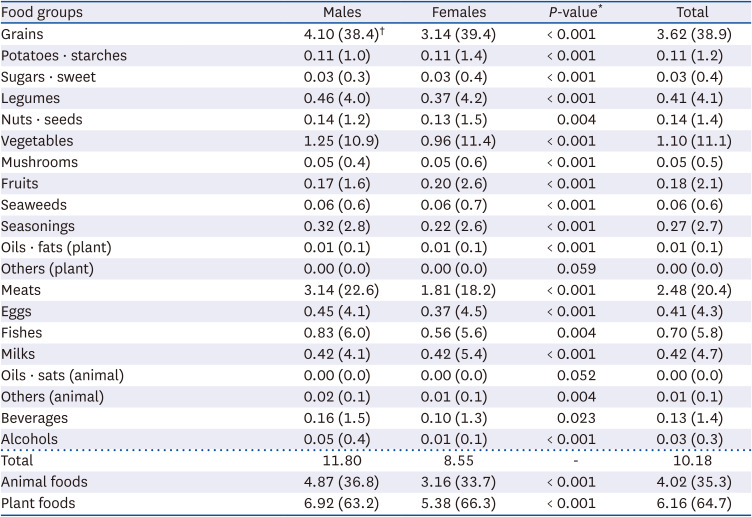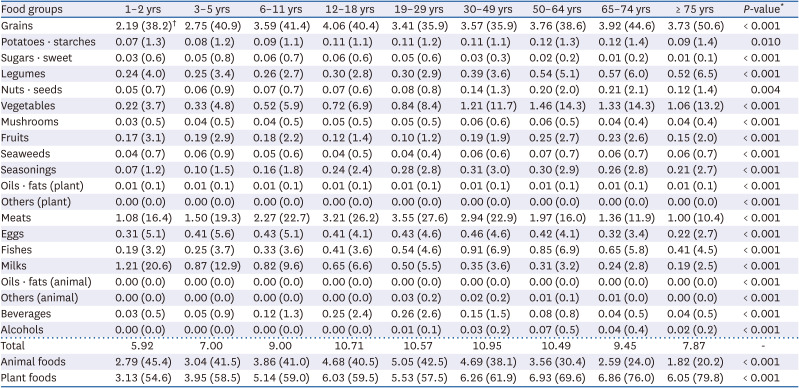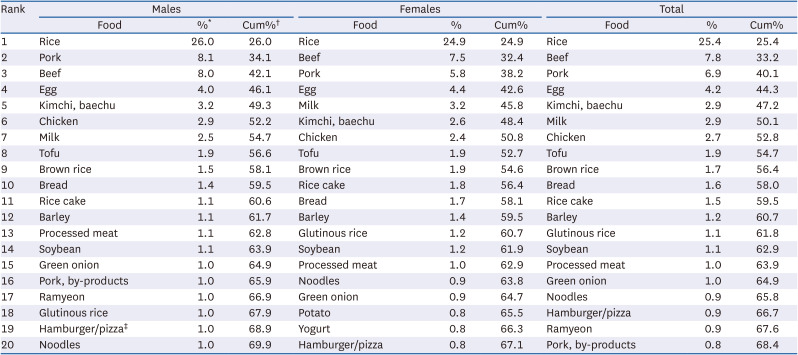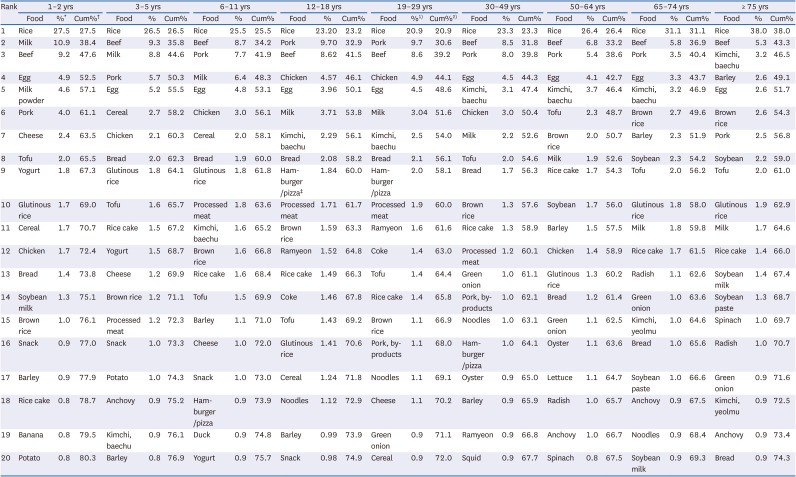1. Ministry of Health and Welfare. Korean Nutrition Society. Dietary Reference Intakes for Koreans 2020. Sejong: Ministry of Health and Welfare;2020.
2. Li Z, Li B, Song X, Zhang D. Dietary zinc and iron intake and risk of depression: a meta-analysis. Psychiatry Res. 2017; 251:41–47. PMID:
28189077.
3. Lee DY, Prasad AS, Hydrick-Adair C, Brewer G, Johnson PE. Homeostasis of zinc in marginal human zinc deficiency: role of absorption and endogenous excretion of zinc. J Lab Clin Med. 1993; 122:549–556. PMID:
8228573.
4. Herbst CA, Menon KC, Ferguson EL, Thomson CD, Bailey K, Gray AR, Zodpey S, Saraf A, Das PK, Skeaff SA. Dietary and non-dietary factors associated with serum zinc in Indian women. Biol Trace Elem Res. 2014; 161:38–47. PMID:
25080861.
5. Prasad AS. Clinical, endocrinological and biochemical effects of zinc deficiency. Clin Endocrinol Metab. 1985; 14:567–589. PMID:
3905080.
6. de Benoist B, Darnton-Hill I, Davidsson L, Fontaine O, Hotz C. Conclusions of the joint WHO/UNICEF/IAEA/IZiNCG interagency meeting on zinc status indicators. Food Nutr Bull. 2007; 28:S480–S484. PMID:
17988008.
7. Gupta S, Brazier AK, Lowe NM. Zinc deficiency in low- and middle-income countries: prevalence and approaches for mitigation. J Hum Nutr Diet. 2020; 33:624–643. PMID:
32627912.
8. Smith MR, DeFries R, Chhatre A, Ghosh-Jerath S, Myers SS. Inadequate zinc intake in India: past, present, and future. Food Nutr Bull. 2019; 40:26–40. PMID:
30974983.
9. Reider CA, Chung RY, Devarshi PP, Grant RW, Hazels Mitmesser S. Inadequacy of immune health nutrients: intakes in US adults, the 2005-2016 NHANES. Nutrients. 2020; 12:1735. PMID:
32531972.
10. Olza J, Aranceta-Bartrina J, González-Gross M, Ortega RM, Serra-Majem L, Varela-Moreiras G, Gil Á. Reported dietary intake and food sources of zinc, selenium, and vitamins A, E and C in the Spanish population: findings from the ANIBES study. Nutrients. 2017; 9:697. PMID:
28684689.
11. Rangan AM, Samman S. Zinc intake and its dietary sources: results of the 2007 Australian National Children’s Nutrition and Physical Activity Survey. Nutrients. 2012; 4:611–624. PMID:
22852053.
12. Qin Y, Melse-Boonstra A, Shi Z, Pan X, Yuan B, Dai Y, Zhao J, Zimmermann MB, Kok FJ, Zhou M. Dietary intake of zinc in the population of Jiangsu Province, China. Asia Pac J Clin Nutr. 2009; 18:193–199. PMID:
19713178.
13. Freeland-Graves JH, Sachdev PK, Binderberger AZ, Sosanya ME. Global diversity of dietary intakes and standards for zinc, iron, and copper. J Trace Elem Med Biol. 2020; 61:126515. PMID:
32450495.
14. Arsenault JE, Brown KH. Zinc intake of US preschool children exceeds new dietary reference intakes. Am J Clin Nutr. 2003; 78:1011–1017. PMID:
14594789.
15. Foster M, Samman S. Vegetarian diets across the lifecycle: impact on zinc intake and status. Adv Food Nutr Res. 2015; 74:93–131. PMID:
25624036.
16. Yu KH. A study on the nutrient intakes and zinc nutritional status of preschool children in Ulsan. Korean J Nutr. 2007; 40:385–394.
17. Lee EM, Kim SH. Dietary zinc intake assessed by dietary survey and zinc analysis of foods consumed by elementary schoolchildren in Chungnam province in Korea: comparison between remote rural and urban areas. J Korean Soc Food Cult. 2010; 25:100–107.
18. Bae YJ, Kim MH, Yeon JY. Evaluation of dietary zinc, copper, manganese and selenium intake in female university students. Korean J Community Nutr. 2012; 17:146–155.
19. Jang HB, Lee HY, Han YH, Song J, Kim KN, Hyun T. Changes in food and nutrient intakes of college students between 1999 and 2009. Korean J Community Nutr. 2011; 16:324–336.
20. Son SM, Sung SI. Zinc and copper intake with food analysis and levels of zinc and copper in serum, hair and urine of female college students. Korean J Nutr. 1999; 32:705–712.
21. Park JS, Chyun JH. Dietary zinc analysis and changes of zinc nutriture with zinc supplementation in Korean adults. Korean J Nutr. 1993; 26:1110–1117.
22. Lee SG, Lee DT, Kim HN, Kim AJ, Sung CJ. The comparison mineral intakes with serum lipids and minerals in some rural housewives. J Korean Soc Food Nutr. 1990; 19:411–417.
23. Lee JY, Paik HY, Joung H. Supplementation of zinc nutrient database and evaluation of zinc intake of Korean adults living in rural area. Korean J Nutr. 1998; 31:1324–1377.
24. Choi MK, Kim HS, Lee WY, Lee H, Ze K, Park JD. Comparative evaluation of dietary intakes of calcium, phosphorus, iron, and zinc in rural, coastal, and urban district. J Korean Soc Food Sci Nutr. 2005; 34:659–666.
25. Lee K, Park JR, Seo JS. Nutritional status of the elderly living in a private silver town of Busan metropolitan city, Korea. J Korean Soc Food Sci Nutr. 2007; 36:1293–1299.
26. Korean Nutrition Society. Korea Disease Control and Prevention Agency. Development of Database of Magnesium and Zinc for Korea National Health and Nutrition Examination Survey’s Data Processing. Cheongju: Korea Disease Control and Prevention Agency;2022.
27. Kweon S, Kim Y, Jang MJ, Kim Y, Kim K, Choi S, Chun C, Khang YH, Oh K. Data resource profile: the Korea National Health and Nutrition Examination Survey (KNHANES). Int J Epidemiol. 2014; 43:69–77. PMID:
24585853.
28. Korea Disease Control and Prevention Agency. 2019 Guidebook for Using the Data from Korea National Health and Nutrition Examination Survey. Cheongju: Korea Disease Control and Prevention Agency;2021.
29. National Institute of Agricultural Sciences. Korean Food Composition Table (version 9.1). Wanju: National Institute of Agricultural Sciences;2019.
30. National Institute of Agricultural Sciences. Korean Food Composition Table (version 9.2). Wanju: National Institute of Agricultural Sciences;2020.
31. Shim JS, Kim KN, Lee JS, Yoon MO, Lee HS. Magnesium intake and dietary sources among Koreans: findings from the Korea National Health and Nutrition Examination Survey 2016–2019. Nutr Res Pract. 2023; 17:48–61. PMID:
36777797.
32. Greenfield SS. Food Composition Data, Production, Management and Use. 2nd ed. Rome: FAO/INFOODS;2003.
33. Food and Agriculture Organization of the United Nations. Compilation tool version 1.2.1 (FAO/INFOODS) and user guidelines, International Network of Food Data Systems (INFOODS) [Internet]. Rome: Food and Agriculture Organization;2021. cited 2021 April 15. Available from:
https://www.fao.org/infoods/infoods/software-tools/en/
.
34. National Institute of Agricultural Sciences. Korean Food Composition Table (version 9.3). Wanju: National Institute of Agricultural Sciences;2021.
35. Ministry of Food and Drug Safety. Nutrition Facts of Processed Food (2019). Cheongju: Ministry of Food and Drug Safety;2019.
36. Ministry of Food and Drug Safety. Nutrition Facts of Processed Food (2020). Cheongju: Ministry of Food and Drug Safety;2020.
37. Ministry of Food and Drug Safety. Nutrition Facts of Eating-Out (2019). Cheongju: Ministry of Food and Drug Safety;2019.
38. Ministry of Food and Drug Safety. Nutrition Facts of Eating-Out (2020). Cheongju: Ministry of Food and Drug Safety;2020.
39. Ministry of Education, Culture, Sports, Science and Technology. Standard tables of food composition in Japan- 2021 - (8th Revised Version). Tokyo: Ishiyaku Publishere Inc.;2021.
40. U.S. Department of Agriculture. FoodData Central 2020 [Internet]. Washington, D.C.: U.S. Department of Agriculture;2020. cited 2021 March 7. Available from:
https://fdc.nal.usda.gov/Laboratory
.
42. Shim JS, Oh K, Kim HC. Dietary assessment methods in epidemiologic studies. Epidemiol Health. 2014; 36:e2014009. PMID:
25078382.
43. Korean Nutrition Society. Recommended Dietary Allowances for Koreans. 6th rev. Seoul: Korean Nutrition Society;1995.
44. Korea Disease Control and Prevention Agency. Korea Health Statistics 2020: Korea National Health and Nutrition Examination Survey (KNHANES VIII-2). Cheongju: Korea Disease Control and Prevention Agency;2020.










 PDF
PDF Citation
Citation Print
Print



 XML Download
XML Download